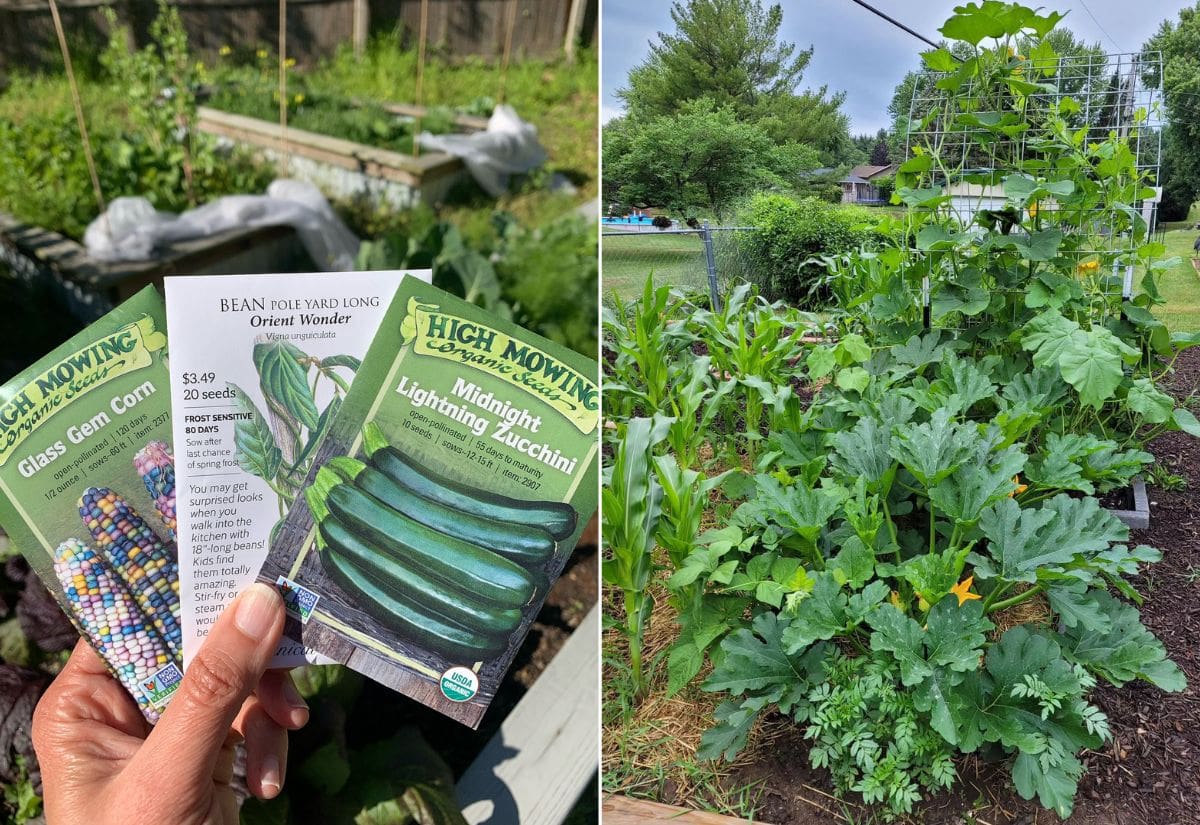
With the right technique and thoughtful plant selection, companion planting can be a highly effective way to maximize the yield of even the smallest of garden plots. Three sisters companion planting is arguably one of the most effective companion planting strategies in the history of agriculture.
If you’ve heard the term before, you might be wondering what are the three sisters and what plants are best for this companion planting strategy?
Three sisters typically call for planting corn, pole beans, and winter squash together so that all three can benefit from each other’s strengths. On a basic level, the corn stalk provides support for pole beans to grow up. The pole beans gather nitrogen from the air and deposit it in the roots of the soil to help feed the corn’s growth. All the while the broad leaves of vining winter squash help shade the soil to retain the moisture levels that all three plants need to thrive.
While it sounds straightforward, there are a few details that can maximize your success. This includes the variety of corn, beans, and squash you choose as well as the timing of how you plant them. To help you make the most out of your three sisters companion planting strategy, we will a closer look at these key factors, as well as some of the best varieties for each type of vegetable.
The History Of The Three Sisters
You might remember a tired old cartoon from elementary school, where the struggling Pilgrims make friends with the Native Americans who teach them how to plant and successfully grow crops in the new world. Most of these early animations show the Iroquois tribe showing them how to plant dead fish in their garden. While this might provide some soil nutrients, burying dead fish in the soil like that is more likely to draw raccoons to your farm rather than provide you with a great bounty.
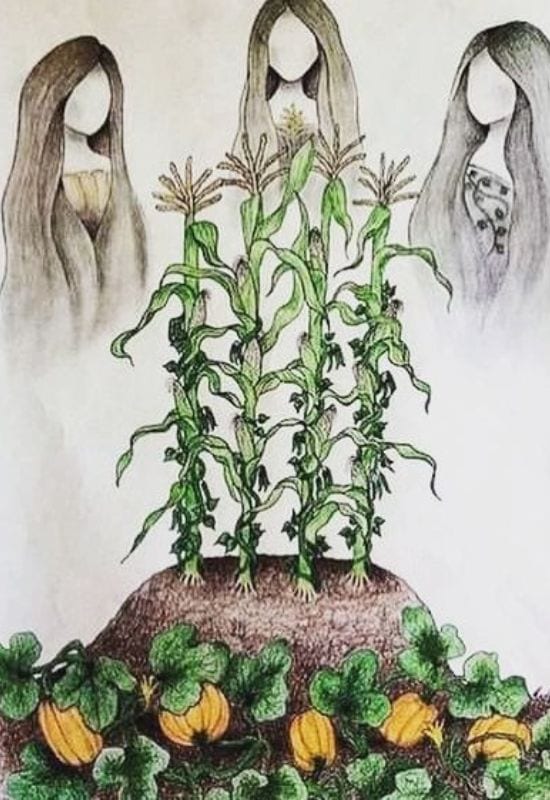
What the Native Americans originally taught the Pilgrims was how to use the new world crops of corn, beans, and winter squash to maximize their harvest. This lead to a great bounty, shared by all which dovetails into the story of the “First Thanksgiving.”
The three sisters technique went on to be used by many family farmers and home-plot gardens for a century or more. As agriculture scaled up, monoculture farming became a more efficient way of feeding large numbers of people. After World War Two farming was gradually industrialized to the point where monoculture farming was seen as the only way forward. This was especially fueled by GMO practices and the advent of insect-resistant BT corn.
Today more and more people are growing heirloom vegetables and looking to explore old gardening traditions to maximize the production of their backyard garden. This includes highly successful companion planting strategies like the three sisters.
Why You Should Plant A Three Sisters Garden
Things like unstable weather patterns, soil depletion, and overpopulation have more and more people worried about the stability of our food supply. This has an increasing number of people starting or expanding their backyard gardens. Though most urban and suburban yards have only a precious few hundred square feet to work with.
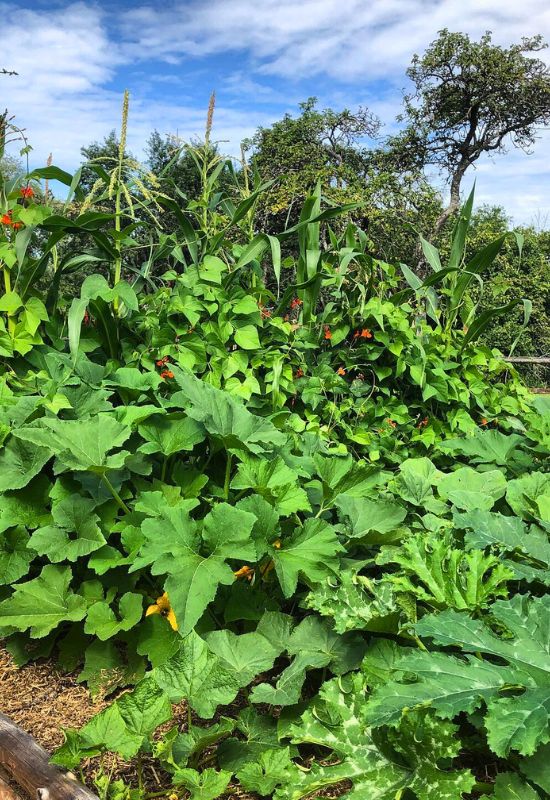
Companion planting techniques like the three sisters let you maximize the yield of even a small garden, with bountiful foods that most people love. Some of the best reasons for growing the three sisters include:
- Access to fresh vegetables
- Maximize your garden’s food production
- Save money off your grocery bills
- Squash, beans & certain types of corn can be stored for winter
- Minimal labor for maximum results
- Grow a lot of food in a small space
- Doesn’t deplete the soil nutrients as monoculture crops do
- No need for frequent rotation
When To Plant Three Sisters
Timing and planting techniques are important components of the three sisters companion planting strategy. All three seeds need warm soil temperatures of 55 to 60 degrees Fahrenheit or more to properly germinate. Though if you plant all three at the same time the corn will not be tall enough to support the beans by the time they are ready to climb.
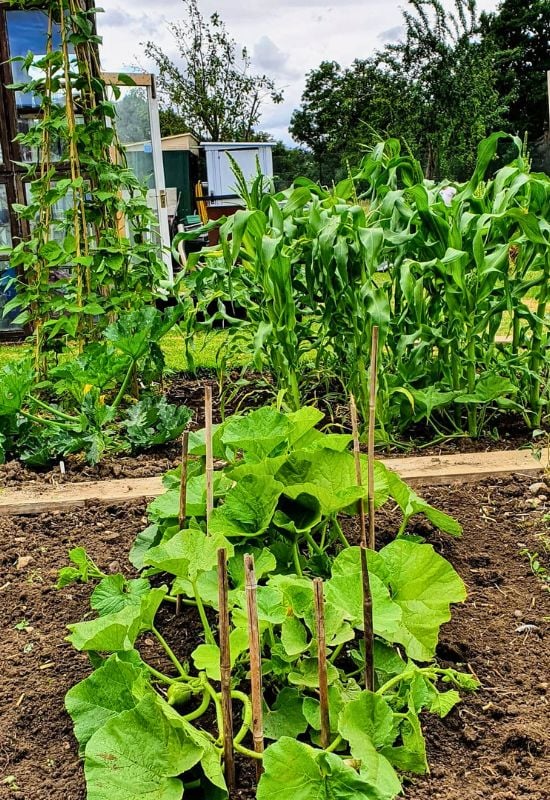
There’s also a chance that early summer rain and sun can give the squash a boost, causing them to grow too vigorously, and take over the garden before the corn and beans have a chance to claim their space in the sun.
Ideally, you want to start the corn at least two weeks before anything else. Corn does best when it is directly sown into the soil.
You can then plant the squash seeds directly into the soil two weeks later. Though if you really want to give them a good boost, you can start them indoors in peat pots over a heated germination pad at the same time you start the corn. You just don’t want to plant them directly in the soil as they prefer cold temperatures to germinate and could rot or be stunted if you plant them too early.
The beans can be planted once the corn reaches around 4 to 6 inches tall. By this time of the summer, the soil temperatures are generally warm enough to let beans germinate quickly. They can then grab ahold of the strong, fast growing corn stalk to start their upward climb.
How to Plant a Three Sisters Garden! (Corn, Beans & Squash)
Step One: Plant The Corn First
Corn can germinate in soil temperature as low as 50 degrees, though 55-degrees or more is best. The roots are very sensitive to any transplanting, so the corn needs to be planted in a loose, rich soil. You should plant it .75 of an inch deep 10 to 14 days before any other seeds. Make sure to water vigorously when first planted.
If an unforeseen cold spell strikes, you will need to water them more, especially at night, to help prevent frost damage. For a smaller patch you can hand water with warm water.
Step Two: Start The Squash Seeds In Peat Pots
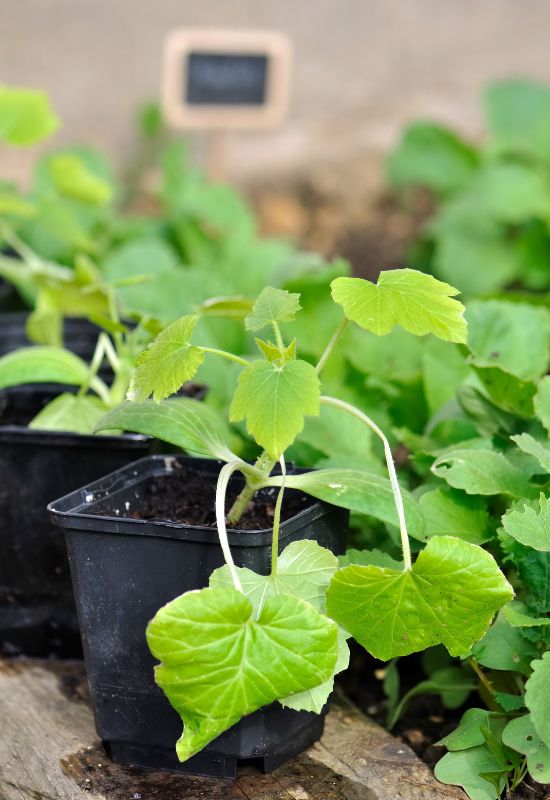
You can start the squash seeds 7 to 10 days after the corn is sewn in the soil. The seeds should be planted on their side in loose seed starter soil in medium-size peat pots. The planting depth should be twice the height of the seed when turned on it’s side. This will allow the germinating seed to rise up quickly while putting down roots at the same time. Then place the peat pots in a heated seed starter. This will give them the 60 to 70-degree soil temperature they want to germinate in.
Peat pots are better than plastic pots as young squash plants have sensitive roots and can die during transplanting from a plastic pot. Though peat pots can be placed directly in the garden soil when they are ready to plant and the roots will naturally grow through the pot as it decays into the soil.
Step Three: Plant The Beans
Beans germinate and grow quickly in warm summer soil, so you can wait to plant them a little later than the corn and squash. Ideally, the corn should be 4 to 6 inches tall before you plant the beans. This will ensure that the stalk of the corn is both enough and tall enough to support the vigorously growing vines of the bean.
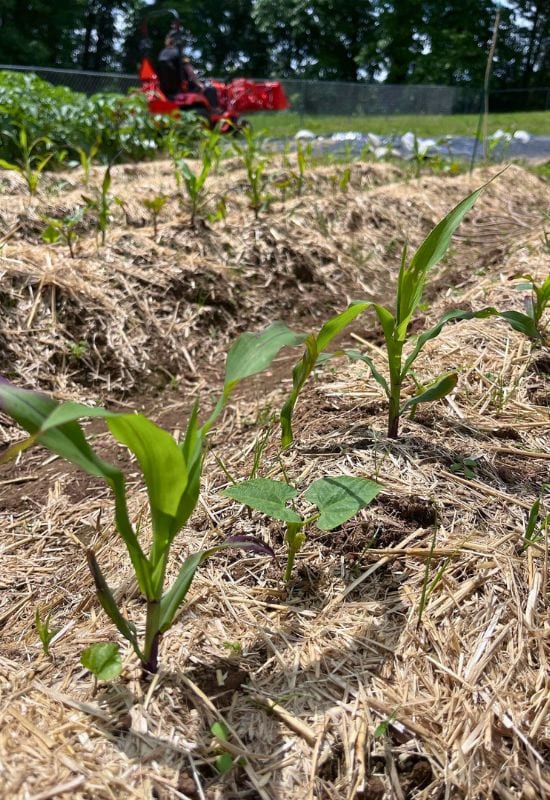
You can plant 1 to 3 bean seeds per stalk of corn, depending on the variety of corn and beans you choose. The bean seeds should be inserted within 2 to 3 inches of the corn stalk at a depth of .75 to 1-inch.
Sewing some organic rhizobium inoculant into the hole you plant the beans into will help boost the plant’s ability to store nitrogen in the soil. Not only will this feed the corn stalk, but it will also help boost your garden soil’s inherent nutrients to fight soil depletion.
How To Lay Out Your Three Sisters Garden Plot
There are a few different strategies to consider for planting the three sisters.
![Three Sisters Gardening: Planting Corn, Beans and Squash Together using Native American Companion Planting 7 Three Sisters Gardening: Planting Corn, Beans and Squash Together using Native American Companion Planting 4]() The Mound Method
The Mound Method
Corn and squash prefer loose soils that allow them to spread their roots deep and wide. This mound method is similar to that used by the Wampanoag Native Americans. It calls for making a series of mounds that are roughly 4 to 6 feet in diameter. Three corn stalks are planted in a triangular layout or four corn stalks are planted in a square shape near the center with 1 foot between them. Beans are then planted 3 to 4 inches away from each corn stalk.
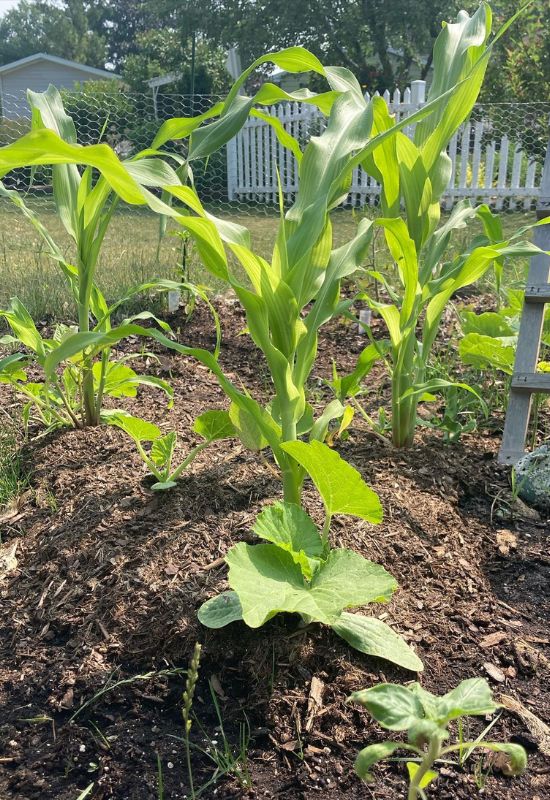
For a corn variety that will produce a stalk of 7 feet or less you should only plant 1 bean plant per stalk. This will give room on the stalk for the vine to wrap itself around without overly shading itself or the corn. A corn variety that can grow 8 feet or more can typically support 2 bean vines. Especially if those bean vines are of a shade-tolerant variety.
You can then plant a squash variety near the perimeter of the mound, with at least one foot of loose soil available. One winter squash plant with carefully tended vines will occupy the entirety of the mound and then some by the end of the summer. If you are going to plant summer squash like zucchini, you could plant two separate vines on opposite sides of the mound.
When you are training the squash vines make sure to give yourself a path into the mound for eventual picking the beans or hand pollinating the corn. You might want to consider placing one or two small paving stones on the mound. This will give you a place to step onto the mound without having to worry about crushing tender roots or compacting the loose soil in the middle of the growing season.
The Row Method
Most home gardens use rows to maximize their space. This is a handed-down agricultural practice that harkens all the way back to the colonists who brought their farming methods from Europe.
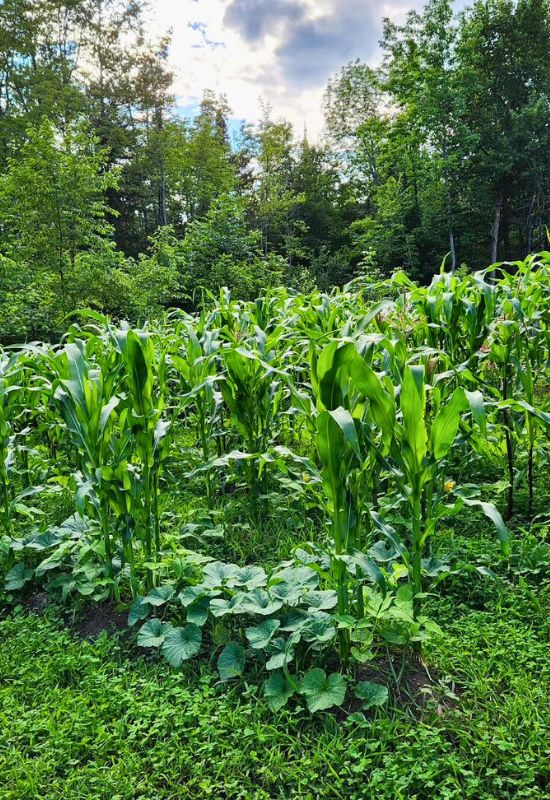
You start by planting rows of corn with 2 feet in between each corn stalk in a row and 2 to 3 feet between each row. If you are going to plant summer squash or sweet corn, you will want to expand the spacing between the rows to 3 to 4 feet to give you room to tiptoe through the three sisters patch. Then again, a bean plant is assigned to each stalk of corn roughly 3 to 4 inches away.
If you are going to plant a non-sweet-corn variety like dent corn or popcorn, or you are going to grow exclusively grow winter squash, you can move the space in between the rows of corn to 2 to 3 feet. Though this tight spacing is more advisable if you are going to plant at least 6 rows of corn, which is just barely enough to allow for sufficient wind pollination. If you are going to have less than 6 rows, you will still need to allow for more spacing between the rows to let you tiptoe into the three sisters patch.
The Combination Row Method
The combination row method is a method you can use for planting summer squash like zucchini as well as winter squash like butternut or acorn squash while minimizing your presence inside the rows. This called for planting your chosen summer squash at the four corners of the rows then planting additional mounds of zucchini every three to four feet along the perimeter.
This minor change in planting strategy allows you to harvest zucchini and other summer squash during the summer, while the winter squash dominates the interior shading the roots of the corn & beans.
Choosing The Right Varieties For Three Sisters
Choosing the best varieties of corn, beans, and squash will also factor heavily into the success of your three sisters’ companion planting strategy.
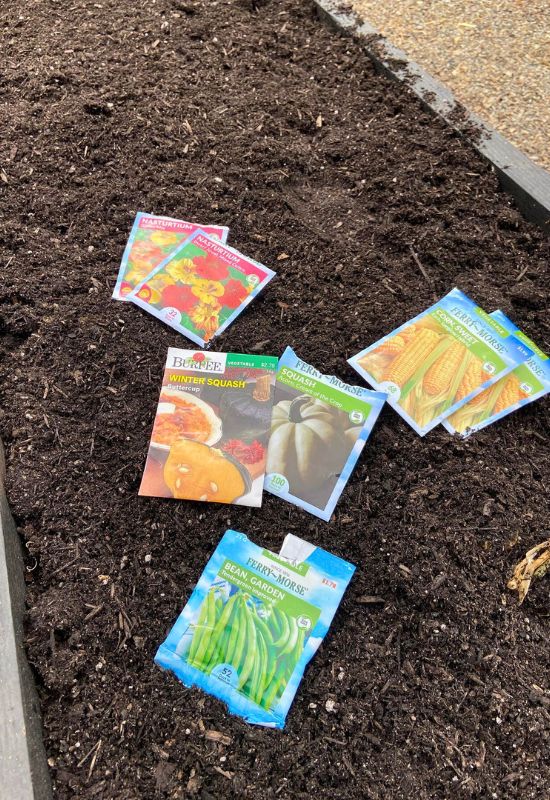
Best Corn For Three Sisters Companion Planting
Traditionally dent corn was used for planting the three sisters. So, we should start there, though there are still some other sweet corn and some possible popcorn varieties that can support the beans growing up the tall stalks. The problem is that with early harvest corn you really need to tiptoe around the squash vines.
- Bloody Butcher – 120 days to maturity, which makes it a better choice for regions with a long growing season in the south. The stalks grow 10 to 12 feet tall which is more than enough to support two or three pole bean vines. It tends to produce 2 ears per stalk. The red kernels are good for grinding in flour, or cereal, as well as feeding backyard chickens.
- Blue Clarage – 100 days to maturity, this dent corn will handle mid-latitude growing seasons. It produced highly uniform, semi-dent corn with vivid blue kernels. It’s a high producer on 10 ft. stalks with 2 ears per stalk. Originally developed as a meal and feed corn with an above-average nutrient profile that is great for feeding backyard chickens and other grain-fed animals.
- Hickory King Dent Corn – This is a type of dent corn very similar to the corn grown by native Americans during the time of the Pilgrims and other early settlers in the new world. It takes 85 to 100 days to reach maturity. Hickory King Dent Corn is often appreciated as a roasting and hominy corn as the kernels are easily removed by soaking.
- Country Gentleman – As one of the most popular heirloom sweet corn varieties, it produces 8 to 9-foot tall stalks, with two ears per stalk. With an average maturity time of 90 to 100 days. It’s a great option for sweet corn lovers who want to use the three sisters companion planting method. It’s also an open-pollinated variety, which means you can let a few ears dry on the stalk to save seeds for next year.
- Bodacious – This is hybrid sweet corn that has won awards for its flavor and complexity. While you can’t save the seeds from the ears each cob is sure to be delicious. The stalks grow to be around 8-feet tall, which is enough to support a single bean vine, and produces two ears per stalk.
- Pennsylvania Butter – This is an heirloom popcorn variety that tastes like it’s buttered even when popped plain. The stalks grow to 8 to 9 feet tall, which is enough to support one or perhaps two pole bean vines. It makes two bountiful ears per stalk, and the seeds can be saved for next year’s planting.
Do I Need To Hand Pollinate Corn Grown In The Three Sisters Method?
Corn is pollinated by the wind. In a large farm field, the density of pollen flowing on the wind is generally more than enough to pollinate all the various stalks and ears. If you have a smaller garden with 6 or fewer rows of corn, you will likely need to hand pollinate your corn to get fully developed ears. Left unchecked a small patch of corn that isn’t properly pollinated will deliver inconsistent ears with patches of developing kernels, rather than large tightly packed rows.
How To Hand Pollinate Corn
Corn has both male and female flowers on each stalk. The male flowers or “Tassel” is the part of the plant that looks like grass that has over-grown and gone to seed. You can usually find it at the very top of the stalk.
As the cornstalk matures the tassel ripens and opens casting pollen from the center of the stalk down toward the lower fronds. Each female part of a cornstalk is located at leaf junctions of the ears, and looks like strands of “Silk.” If you were to look inside the immature ear you would see that each kernel is attached to a single silk. Left to its own devices a small patch of corn without sufficient pollen density will only have a successful pollination rate of 3 to 7%. This is why thorough hand-pollinating is so important with small three sisters gardens.
Timing is absolutely critical when it comes to hand pollinating corn. You want the tassels to be fully developed with noticeably swollen, open, and releasing yellow pollen in tiny, powdery clusters. Corn plants also tend to release their pollen in mid-morning after the early morning dew has dried up. This usually happens within an hour before or after 10 am. For most effective hand-pollinating you should continue to use the following steps every morning for at least a week.
- Step 1: Snap the tassels off 2 to 3 stalks.
- Step 2: Dust over the emerging silks at each ear.
- Step 3: Work down one entire row and then back again.
- Step 4: Repeat this process with the next row using fresh tassels.
Best Beans For Three Sisters Companion Planting
Virtually all pole beans will grow well with the “Pole” provided by the stalk of corn. Though some varieties do better in the conditions created by the three sisters companion planting method. Especially shade-tolerant varieties if you can find them.
- Blue Lake Pole Snap Bean – Known for being semi-shade tolerant and successful when grown in the three sisters companion planting method. It days 63 days to reach maturity and is a heavy producer of 5 to 6-inch long pods.
- Cherokee Cornfield Pole Snap Bean – This pole bean has a reputation for growing well in the three sisters companion planting method. It has 58 days to maturity for a large yield. It’s an heirloom pole bean with pretty earth tone shades and markings. Yields well, especially when grown-up corn stalks.
- Kentucky Wonder – One of the most popular and successful of all pole beans. 66 days to maturity and is known for being semi-shade tolerant as well as resistant to bean rust. It produces 8-inch pods, that are stringless and tender when small.
- Rattle Snake Pole Snap Bean – 56 days to maturity. This pole bean has a reputation for being a heavy producer, especially in hot, humid areas. It also does well in sandy soil prevails. The vigorous vines bear 6 to 7 inch long pods.
Best Squash For Growing In The Three Sisters Method
Winter squash tends to be the traditional squash pairing for the three sisters companion planting method. You can let them grow all summer long without having to disturb the patch to pick them like you would with fresh-use summer squash.
Though if you are willing to do some careful tiptoeing through the garden, you can certainly grow summer squash varieties like zucchini and patty pan. So, we tried to break these down into winter and summer squash varieties.
The Best Winter Squash For Three Sisters
- Honeynut Winter Squash – This is a variety of butternut squash with a hint of honey flavor and more sweetness than many other butternut varieties. It also produces smaller squash, which is handy for a couple or a small family. Days to maturity average around 95 to 100 days, which is handy for shorter growing seasons.
- Galeux d’ Eysines – This is technically a French pumpkin that is known for its warty exterior. While they might be ugly to look at, the warts are a sign of high sugar content. They are very flavorful and perfect for stuffing and roasting. The average days to maturity around 95 to 105 days.
- Waltham Butternut – This is one of the most successful and popular types of butternut squash grown in gardens and on commercial farms. While it’s a little unimaginative, it’s a quality, winter squash that’s easy to grow and maintain. The average days to maturity is 90 to 100 days.
- Seminole Pumpkin – This is a Certified Organic that is well-suited to the Southeaster small farms. It is a high producer making many small fruits that are great for roasting as well as making into a traditional scratch pumpkin pie. The vines are highly resistant to vine borers and exhibit superior downy mildew resistance. When harvested and stored properly Seminole pumpkins can keep for 9 to 12 months, which makes them great for families that love to put up squash for long-term storage.
The Best Summer Squash For Three Sisters
- Costata Romanesca –This Italian heirloom zucchini has an average of 62 days to maturity. It is well known for its flavor as well as tenderness, even when the fruits grow large. This makes it a great option for gardeners who have a habit of letting one or two overgrow accidentally. The vines are also very hardy and stand up to frequent changes in weather.
- Cocozelle – This is another beloved Italian heirloom zucchini that produces long and cylindrical fruits on hardy vines. They are best when harvested around 10 to 12 inches long, and will become increasingly yellow as they mature.
- Benning’s Green Tint Summer Squash – This is a Certified Organic Heirloom “Patty Pan” summer squash that does well in hot, humid conditions. It has an average of 52 days to maturity and produced fruits with fine-textured flesh known for good flavor.
- Tromboncino Summer – This heirloom “Crookneck” summer squash has an average of 60 days to maturity. The vines are vigorous, and can also be grown on a trellis, so keep an eye out to make sure that they don’t attempt to grow up the corn stalk.
Frequently Asked Questions
Can I Grow Sunflowers Instead Of Corn For Three Sisters?
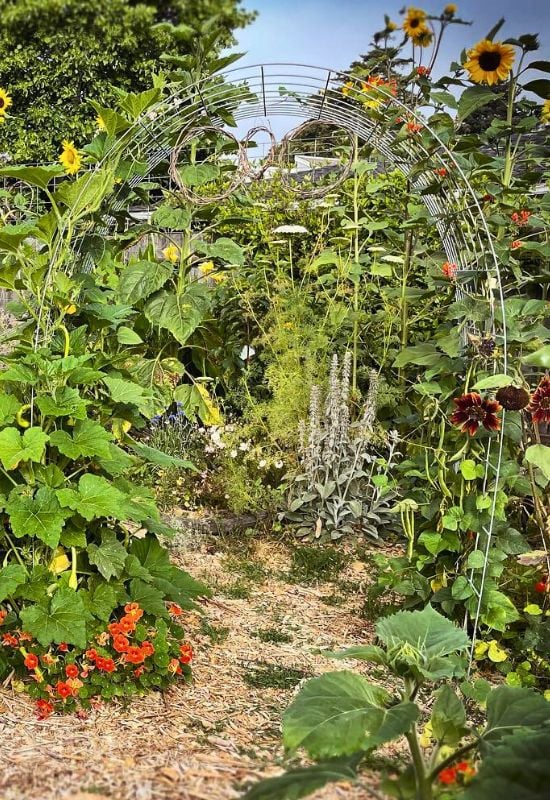
Sunflowers and beans don’t grow well together. The beans tend to have a lower overall yield. Though sunflowers are more likely to attract pollinators to your garden. If you aren’t interested in corn and you are content with a low yield of beans, but you want to attract more bees and butterflies for other plants in your garden a few sunflowers will help. Though you’ll need a tall variety like Mongolian Giant and they will need three to four weeks head start to be strong enough to support the beans.
Can I Grow Bush Beans In Three Sisters?
Bush beans can be grown near corn in a three sisters companion planting strategy, and you will get the benefit of nitrogen capture in the soil. Though bush beans do not climb like pole beans do, and they end up taking up a lot more space. So, bush beans are not ideal.
Can I Grow French Runner Beans In Three Sisters
French runner beans are one of the few pole beans that do a poor job of capturing nitrogen. While they will benefit from the “Pole” of the corn stalk, they won’t contribute anything else to the equation. They also prefer full sun and may have a reduced yield when growing in a tightly spaced three sisters garden, compared to a shade-tolerant variety of pole beans like Kentucky Wonder.
What Is Rhizobium Inoculant?
Rhizobium bacteria existing naturally in most soils. Legumes like pole beans take atmospheric nitrogen from the air and transform or fix it into a plant-available form through the process called Biological Nitrogen Fixation. The legumes and rhizobium bacteria form a beneficial symbiotic relationship in the soil. This causes the Rhizobia to form root nodules on the host legume which helps boost growth for the surrounding plants as well as combating soil depletion.
Sowing Rhizobium Inoculant into the soil near the beans you plant will help boost natural soil levels organically in the first year. It will also leave residually higher levels of beneficial bacteria in the soil for two or possibly three years afterward. This is a great way to maintain healthy soil nitrogen levels in a relatively small urban or suburban garden.
Conclusion
The three sisters are arguably the most successful companion planting strategy in the history of agriculture. A robust corn stalk supports and vigorous pole bean vine. The pole bean then returns the favor by depositing nitrogen into the soil to feed the corn stalk. All the while the vines and broad leaves of the squash plant help shade the soil to maintain the ambient moisture levels all three plants need to thrive.
Traditionally three sisters are grown with hard dent corn that can be ground into masa corn flour or cracked for backyard chicken feed. Though sweet corn varieties are also popular. You just need to be careful picking them, to avoid damaging the vines underfoot. Just bear in mind that a smaller corn patch might need hand pollinating to make sure you get a robust volume of mature kernels.
When it comes to the squash vines winter squash and pumpkins are more traditional. Though you could certainly plant summer squash like zucchini if you are willing to tip-toe through the garden. Another way to get the best of both worlds is to plant your favorite zucchini and summer squash at the border of the three sisters patch where they will be easy to harvest. Then let winter squash grow as they please in the middle of the interior rows.

Written By
Amber Noyes
Amber Noyes was born and raised in a suburban California town, San Mateo. She holds a master’s degree in horticulture from the University of California as well as a BS in Biology from the University of San Francisco. With experience working on an organic farm, water conservation research, farmers’ markets, and plant nursery, she understands what makes plants thrive and how we can better understand the connection between microclimate and plant health. When she’s not on the land, Amber loves informing people of new ideas/things related to gardening, especially organic gardening, houseplants, and growing plants in a small space.
